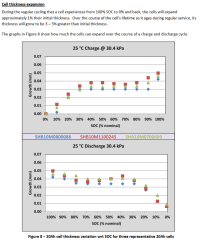Dr. Dickie
Member
- Joined
- Sep 23, 2020
- Messages
- 363
I am preparing to get into lithium iron phosphate (which was my ultimate goal). I will probably just put together a 12V system to replace my lead-acid system that runs my HAM radio, a small back-up fridge, and the solar garden pump. More info than you need.
My question is: I see many people are apposed to compression of the prismatic cells, even when the manufacture calls for compression. Now I don't plan to squeeze the heck of the cells, but what is the downside to setting the cells up in a manner where they cannot swell easily (or significantly, I guess). Just wondering so I can make my own decision about whether to or how to compress.
Thanks
My question is: I see many people are apposed to compression of the prismatic cells, even when the manufacture calls for compression. Now I don't plan to squeeze the heck of the cells, but what is the downside to setting the cells up in a manner where they cannot swell easily (or significantly, I guess). Just wondering so I can make my own decision about whether to or how to compress.
Thanks




